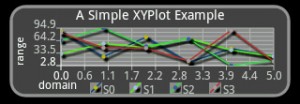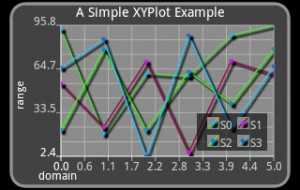Customizing the Legend
[doc_header]
[last_updated_for version=0.3d]
Overview
This doc will show you how the legend widget works and how to modify it to suit your needs.
A Basic Legend
A plot's legend widget is essentially a table. Each cell within the table is assigned a series from within the plot. The number of rows and columns of this table are configurable.
Let's start with a basic example of a plot with 4 series assigned to it. This is what it looks like:

Figure 1: A basic legend
layout/main.xml
<?xml version="1.0" encoding="utf-8"?>
<LinearLayout xmlns:android="http://schemas.android.com/apk/res/android"
android:orientation="vertical"
android:layout_width="fill_parent"
android:layout_height="fill_parent">
<com.androidplot.xy.XYPlot
android:id="@+id/mySimpleXYPlot"
android:layout_width="fill_parent"
android:layout_height="100px"
android:layout_marginTop="10px"
android:layout_marginLeft="10px"
android:layout_marginRight="10px"
title="A Simple XYPlot Example"/>
</LinearLayout>
And here's the code:
MyActivity.java
package com.example;
import android.app.Activity;
import android.graphics.Color;
import android.os.Bundle;
import com.androidplot.ui.layout.SizeLayoutType;
import com.androidplot.ui.layout.SizeMetrics;
import com.androidplot.ui.layout.TableModel;
import com.androidplot.xy.SimpleXYSeries;
import com.androidplot.series.XYSeries;
import com.androidplot.xy.*;
import java.util.Arrays;
import java.util.Vector;
public class MyActivity extends Activity
{
private XYPlot mySimpleXYPlot;
@Override
public void onCreate(Bundle savedInstanceState)
{
super.onCreate(savedInstanceState);
setContentView(R.layout.main);
// initialize our XYPlot reference:
mySimpleXYPlot = (XYPlot) findViewById(R.id.mySimpleXYPlot);
// randomly generate 4 series of data and add them to the plot.
// values are all within the range of 0 - 100
for (int i = 0; i < 4; i++) {
Number[] seriesNumbers = {
Math.random() * 100,
Math.random() * 100,
Math.random() * 100,
Math.random() * 100,
Math.random() * 100,
Math.random() * 100};
LineAndPointFormatter lpFormatter = new LineAndPointFormatter(
Color.rgb(
new Double(Math.random()*255).intValue(),
new Double(Math.random()*255).intValue(),
new Double(Math.random()*255).intValue()),
Color.rgb(
new Double(Math.random()*255).intValue(),
new Double(Math.random()*255).intValue(),
new Double(Math.random()*255).intValue()),
Color.rgb(
new Double(Math.random()*255).intValue(),
new Double(Math.random()*255).intValue(),
new Double(Math.random()*255).intValue()));
lpFormatter.setFillPaint(null);
mySimpleXYPlot.addSeries(
new SimpleXYSeries(
Arrays.asList(seriesNumbers), // SimpleXYSeries takes a List so turn our array into a List
SimpleXYSeries.ArrayFormat.Y_VALS_ONLY, // Y_VALS_ONLY means use the element index as the x value
"S" + i),
lpFormatter); // Set the display title of the series);
}
mySimpleXYPlot.getLegendWidget().setSize(new SizeMetrics(11, SizeLayoutType.ABSOLUTE, 170, SizeLayoutType.ABSOLUTE));
// reduce the number of range labels
mySimpleXYPlot.setTicksPerRangeLabel(3);
// by default, AndroidPlot displays developer guides to aid in laying out your plot.
// To get rid of them call disableAllMarkup():
mySimpleXYPlot.disableAllMarkup();
}
}
Nothing wrong there. By default the legend widget has one row by n columns. Each of the n columns shares an equal amount of the available screen realestate assigned to the legend widget. But what if you don't one a single row of legend items? What if you want a 2 x 2 grid instead? Read on...
A 2x2 Legend Example
Working with the above code, let's make a few changes. First, we are going to need to expand our plot to give us more room to work with. Edit main.xml and give our XYPlot a height of 200 pixels:
Somewhere around line 62 add the following code:
// use a 2x2 grid:
mySimpleXYPlot.getLegendWidget().setTableModel(new DynamicTableModel(2, 2));
// adjust the legend size so there is enough room
// to draw the new legend grid:
mySimpleXYPlot.getLegendWidget().setSize(new SizeMetrics(40, SizeLayoutType.ABSOLUTE, 75, SizeLayoutType.ABSOLUTE));
// add a semi-transparent black background to the legend
// so it's easier to see overlaid on top of our plot:
Paint bgPaint = new Paint();
bgPaint.setColor(Color.BLACK);
bgPaint.setStyle(Paint.Style.FILL);
bgPaint.setAlpha(140);
mySimpleXYPlot.getLegendWidget().setBackgroundPaint(bgPaint);
// adjust the padding of the legend widget to look a little nicer:
mySimpleXYPlot.getLegendWidget().setPadding(10, 1, 1, 1);
// reposition the grid so that it rests above the bottom-left
// edge of the graph widget:
mySimpleXYPlot.position(
mySimpleXYPlot.getLegendWidget(),
20,
XLayoutStyle.ABSOLUTE_FROM_RIGHT,
35,
YLayoutStyle.ABSOLUTE_FROM_BOTTOM,
AnchorPosition.RIGHT_BOTTOM);
Which gives us this:

Figure 2: A 2x2 legend
Unbounded Grids
TODO
Row Major and Column Major Orientation
TODO


